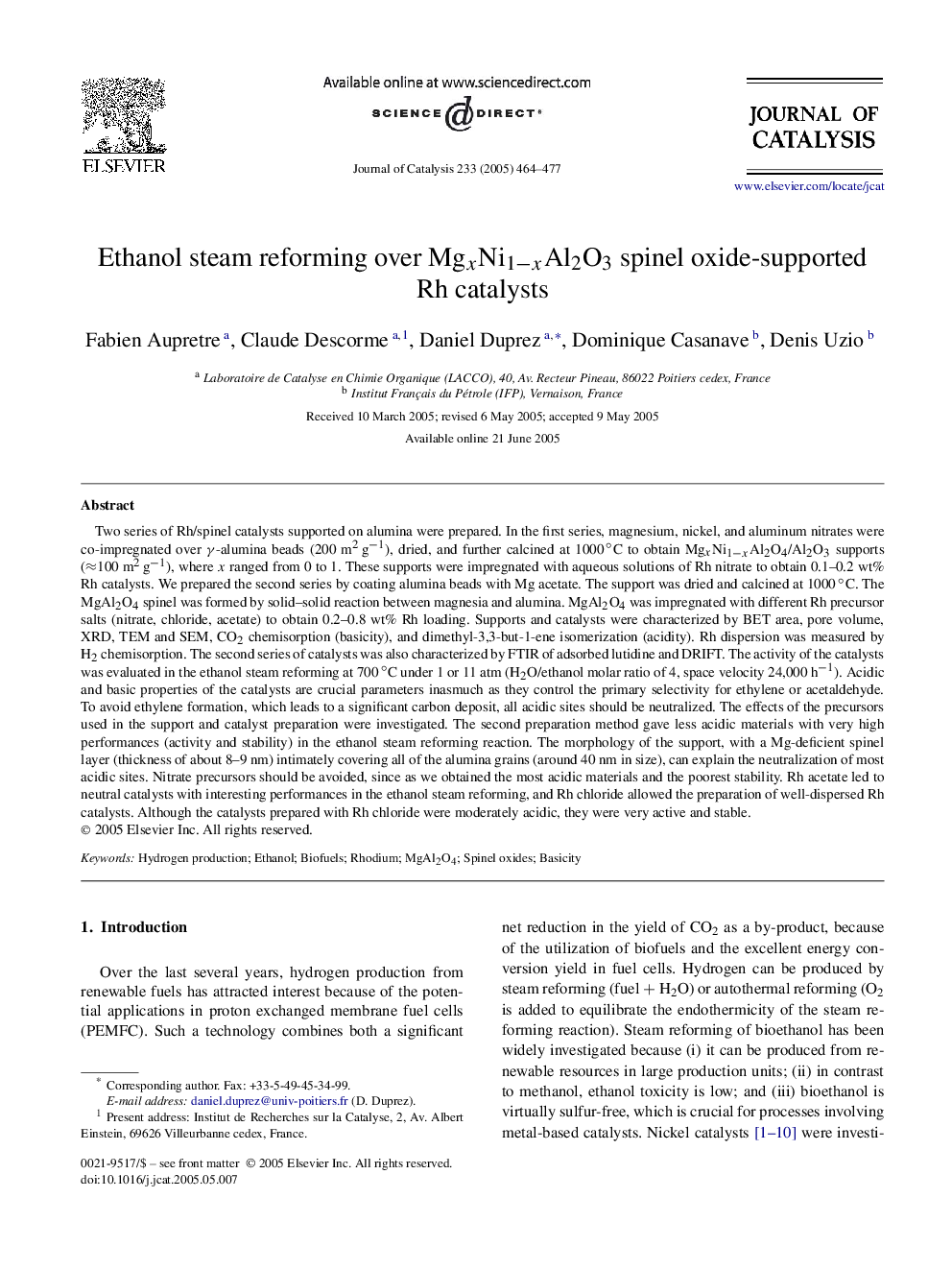| کد مقاله | کد نشریه | سال انتشار | مقاله انگلیسی | نسخه تمام متن |
|---|---|---|---|---|
| 10244492 | 47690 | 2005 | 14 صفحه PDF | دانلود رایگان |
عنوان انگلیسی مقاله ISI
Ethanol steam reforming over MgxNi1âxAl2O3 spinel oxide-supported Rh catalysts
دانلود مقاله + سفارش ترجمه
دانلود مقاله ISI انگلیسی
رایگان برای ایرانیان
کلمات کلیدی
موضوعات مرتبط
مهندسی و علوم پایه
مهندسی شیمی
کاتالیزور
پیش نمایش صفحه اول مقاله

چکیده انگلیسی
Two series of Rh/spinel catalysts supported on alumina were prepared. In the first series, magnesium, nickel, and aluminum nitrates were co-impregnated over γ-alumina beads (200 m2âgâ1), dried, and further calcined at 1000â°C to obtain MgxNi1âxAl2O4/Al2O3 supports (â100 m2âgâ1), where x ranged from 0 to 1. These supports were impregnated with aqueous solutions of Rh nitrate to obtain 0.1-0.2 wt% Rh catalysts. We prepared the second series by coating alumina beads with Mg acetate. The support was dried and calcined at 1000â°C. The MgAl2O4 spinel was formed by solid-solid reaction between magnesia and alumina. MgAl2O4 was impregnated with different Rh precursor salts (nitrate, chloride, acetate) to obtain 0.2-0.8 wt% Rh loading. Supports and catalysts were characterized by BET area, pore volume, XRD, TEM and SEM, CO2 chemisorption (basicity), and dimethyl-3,3-but-1-ene isomerization (acidity). Rh dispersion was measured by H2 chemisorption. The second series of catalysts was also characterized by FTIR of adsorbed lutidine and DRIFT. The activity of the catalysts was evaluated in the ethanol steam reforming at 700â°C under 1 or 11 atm (H2O/ethanol molar ratio of 4, space velocity 24,000 hâ1). Acidic and basic properties of the catalysts are crucial parameters inasmuch as they control the primary selectivity for ethylene or acetaldehyde. To avoid ethylene formation, which leads to a significant carbon deposit, all acidic sites should be neutralized. The effects of the precursors used in the support and catalyst preparation were investigated. The second preparation method gave less acidic materials with very high performances (activity and stability) in the ethanol steam reforming reaction. The morphology of the support, with a Mg-deficient spinel layer (thickness of about 8-9 nm) intimately covering all of the alumina grains (around 40 nm in size), can explain the neutralization of most acidic sites. Nitrate precursors should be avoided, since as we obtained the most acidic materials and the poorest stability. Rh acetate led to neutral catalysts with interesting performances in the ethanol steam reforming, and Rh chloride allowed the preparation of well-dispersed Rh catalysts. Although the catalysts prepared with Rh chloride were moderately acidic, they were very active and stable.
ناشر
Database: Elsevier - ScienceDirect (ساینس دایرکت)
Journal: Journal of Catalysis - Volume 233, Issue 2, 25 July 2005, Pages 464-477
Journal: Journal of Catalysis - Volume 233, Issue 2, 25 July 2005, Pages 464-477
نویسندگان
Fabien Aupretre, Claude Descorme, Daniel Duprez, Dominique Casanave, Denis Uzio,